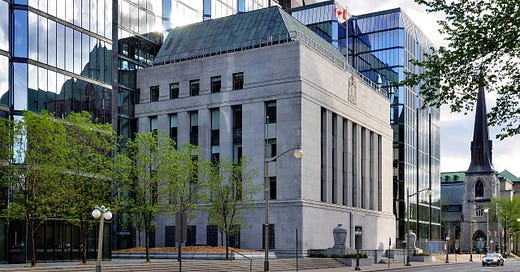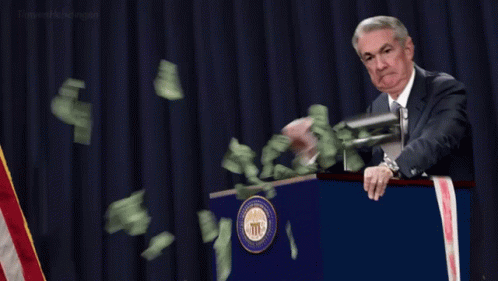Don't let Pierre Poilievre scare you from asking the big questions
Someone has to do it: the Bank of Canada's own history shows us why we should be sceptical of its foray into digital currency
Pierre Poilievre wants to ban the Bank of Canada from issuing a digital currency. Though it has no immediate plan to launch one, it’s readying itself to. If a stablecoin or cryptocurrency challenges its monetary authority, it wants to be ready to crowd out the challenge with a digital currency of its own. That’s basically what the Bank of Canada’s Timothy Lane said a couple of years ago, clashing with Poilievre’s more recent aspiration to make Canada the “blockchain capital of the world.”
Poilievre has made no secret of his disdain for the Bank of Canada. At the outset of the pandemic, the Conservative MP called it the Liberal government’s “ATM,” alleging that it was enabling the government’s extraordinary spending and debasing the Canadian dollar. The other week, he did the same. “You know who’s damaging the credibility of the Bank of Canada?” he rhetorically asked. “Justin Trudeau—by using the central bank to finance his out-of-control inflationary deficits.” The other day, he said he’d fire the governor of the Bank of Canada, Tiff Macklem.
Say what you will of Poilievre and his tactics. I’m no fan of them for the same reasons others aren’t. But we should be asking whether central bank digital currency is a solution in search of a problem.
The Bank of Canada’s own history shows us why.
A reflexive, shallow answer to a political question?
Before the Bank of Canada, banks issued their own money. Becoming a bank wasn’t difficult back then. One historian writing in the early 1900s said bank charters were “easily obtained” from parliament. In fact, Canada’s monetary system was largely unregulated until the 1890 version of the Bank Act came into effect and the Bank of Canada was established in 1934.
So what changed and set the stage for central banking? This is a question economists Michael D. Bordo and Angela Redish tried to answer by testing three competing hypotheses.
The first hypothesis is that the Bank of Canada emerged because central banks are natural consequences of the fractional reserve system. In such banking systems, there will be runs on banks. And when there are runs, there will be a need for a lender of last resort: an institution that injects enough liquidity in the system so that institutions don’t fail to make good on their depository promises and cause further panic, destabilizing the whole system. It makes more sense for this to be a public institution, rather than a commercial bank, because of the tension between the interests of the bank’s shareholders and those of the broader public.
That wasn’t it, argued Bordo and Redish. “The structure of the Canadian banking system changed considerably between the emergence of the first chartered bank in 1822 and the 1930s,” they wrote, “but the process of evolution did not result in the introduction of central banking.”
The Bank of Montreal started to look something like a lender of last resort in the 1800s, but it never quite assumed the role because it didn’t have to. Relative to the United States, Canada had an efficient and elastic supply of private money. Canada’s nationwide branch network, which was less restrictive than the United States’, allowed for the emergence of larger and more diversified banks. Canadian banks were better positioned to withstand shocks. What’s more, restrictions on note issuance made it hard for American banks to match supply with demand. Meanwhile, Canadian banks didn’t have the same restrictions and were freer to issue more notes when they needed to. Of course, pre-1934 Canadian banking wasn’t without the periodic glitch. But more oversight, rather than the establishment of a central bank, was how the federal government debugged the system.
The second hypothesis is that the Bank of Canada emerged as a substitute for the gold standard. In the early 1900s, the gold standard was suspended a few times. In the absence of a gold standard—the ability to convert your bank notes into gold on demand—the soundness of the money supply was at risk.
This wasn’t it, either, argued Bordo and Redish. They wrote that there’s “considerable evidence that this hypothesis is at best incomplete.”
There are a few reasons to doubt the second hypothesis. To start, the price level didn’t explode when the gold standard was suspended before the Bank of Canada was created. According to public statements from bankers at the time, the expectation was that the gold standard would be reinstated at a later date, and so banks acted as if nothing had changed. Bordo and Redish did an econometric analysis to see if profit-hungry banks made the money printer go brrr. They found no such thing.
The third hypothesis is that the Bank of Canada’s creation was political. Bordo and Redish got here by a process of elimination. If the Bank of Canada wasn’t a natural consequence of fractional reserve banking, and if it wasn’t a substitute for the gold standard, then it had to have emerged from “a conjuncture of political imperatives.”
At the time, the political ideological conditions were propitious. Historian Donald Creighton wrote that Canadians were increasingly of the idea that economic liberalism was failing and only government intervention could fix it. There was also the very Canadian tendency to follow in the footsteps of our international peers. As central bankers from other countries gathered and cooperated in international fora, our technocrats feared missing out and their calls for a central bank grew stronger. So did the public’s sense of nationalism, which called for institutions to protect Canada’s sovereignty. A national airline. The Canadian Broadcasting Corporation. And, yes, even the Bank of Canada.
The question of whether to establish a central bank in Canada was answered before it was even studied by the Macmillan Commission. Created in 1933, the commission studied whether the government should involve itself more in monetary policy. The commission heard a range of expert testimony before recommending that the government create the Bank of Canada, but none of it mattered. According to one account, the deputy minister of finance at the time only accepted his job when he learned that the prime minister had decided to create the Bank of Canada—a year before the Macmillan Commission was even established. The appointment of a staunch advocate of central banking, Hugh Macmillan, to lead the commission was also suspicious. As the president of the Canadian Bankers Association wrote to a colleague back then, “Confidentially, I think it was decided before Lord Macmillan left London that some kind of a central organization should be established in Canada.”
Still, even if the Bank of Canada was a reflexive and shallow answer to a political question, it doesn’t mean the Bank of Canada was the wrong answer. It just means it was a reflexive and shallow one.
History repeats itself from time to time
It happened once. It can happen again. A central bank digital currency could emerge from “a conjuncture of political imperatives,” rather than some purely technocratic need. This isn’t entirely bad. But it also isn’t entirely good.
It isn’t entirely bad because financial stability is one of those subjects on which most voters don’t have good opinions. Having good opinions is hard. Just consider some titles from the academic press. The Myth of the Rational Voter. Against Democracy. Democracy for Realists: Why Elections Do Not Produce Responsive Government. Democracy and Ignorance: Why Smaller Government Is Smarter. I’d rather the stability of my financial system be determined by a handful of technocrats who are knowledgeable and independent of the politics of the day, even though that, too, isn’t perfect.
It isn’t entirely good, however, because issuing a central bank digital currency is about more than financial stability. For example, it’s also about financial inclusion. There is a trade-off between combating criminal financial activity and access to banking services. Banks are reluctant to give crypto, gambling, adult content, and other types of companies basic banking services because they’re afraid of getting in trouble. For the underbanked, a digital currency outside the financial system is the only refuge. But if the Bank of Canada is issuing one, will it take risks where reputable banks won’t? You can’t be independent from the political process if you’re doing political things, namely, making decisions that change the distribution of well-being across society. That’s like having your cake and eating it too.
It’s also not entirely good because there are other policy options for protecting the stability of the financial system, which don’t involve issuing a central bank digital currency.
Instead of looking to provide an alternative to stablecoins and cryptocurrency, the federal government could simply regulate them more effectively. Amend the Payments Clearing and Settlement Act so that the Bank of Canada has the authority to designate stablecoin arrangements. Include virtual currencies in the scope of the Retail Payment Activities Act, which passed in 2021, and whose regulations are likely being drafted as I write these words. In the upcoming review of the Bank Act, make issuing stablecoins something that only federally regulated banks can do. Don’t have another go at standing up a national securities regulator, but give the provinces attention and support as they develop a harmonized approach to overseeing crypto-asset trading platforms. My point is not that these are better options. My point is that these are other options.
If the Bank of Canada issues its own digital currency, it shouldn’t be a reflexive and shallow answer to a political question. It should be a deliberate and thoughtful one. But if history is a guide, there’s a non-trivial possibility it won’t be.





